
Disney, Fleischer, Warner and Lantz provide the weather action this week, including double-doses of Popeye and Porky Pig, and two pre-MGM efforts of director Tex Avery. As usual, Disney provides the more sophisticated graphics, though the competition attempts to compensate (sometimes successfully) with funny gags and wild scenarios.
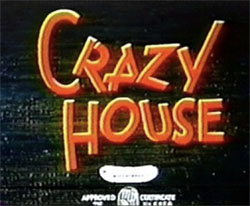 Crazy House (Lantz/Universal, Andy Panda, 9/23/40 – Walter Lantz, dir.) – Not too much (save one shot of lightning) is depicted onscreen of an actual storm, but the results of its aftermath are replete to the eye. A rainy night has left a remote country road (on the way to the destination of the town of Pandamonium) a washed-out mess, etched with deep tire tracks and muddied to the point where each passing tire builds up a complete coating of the stuff around itself, then has to give a pronounced kick to jettison the sticky soil off. Andy and his portly father are the weary travelers traversing this obstacle course in the dead of night, and making the progress of a speedy snail down the highway. (This film marked a departure for Andy’s series, previously cast by Burt Gillett and Alex Lovy in the setting of a pygmy-inhabited steaming jungle. Here for the first time, the characters have left the jungle, ad acquired traits of typical humans, with Father wearing a derby hat, and driving a jalopy automobile.) As the car “progresses” down the road, it encounters a seemingly harmless puddle – which turns out to be deep enough below the water’s surface to entirely submerge the car, and Pop too. Andy spots a strange looking house in the darkened shadows, and Pop declares “We’ll spend the night in there.” (Note a sound recording or editing error, as Andy’s Pop mouths the word “C’mon.” before delivering the line, but no dialogue is heard to match.) They race for the door of the house, but Andy is faster than his old man, and slams the door in Papa’s face. After re0inflating his flattened face and torso, Pop storms into the house, also slamming the door. A sign falls from a mounting above at the force of the impact, reading “Crazy House. Closed for the Season.”
Crazy House (Lantz/Universal, Andy Panda, 9/23/40 – Walter Lantz, dir.) – Not too much (save one shot of lightning) is depicted onscreen of an actual storm, but the results of its aftermath are replete to the eye. A rainy night has left a remote country road (on the way to the destination of the town of Pandamonium) a washed-out mess, etched with deep tire tracks and muddied to the point where each passing tire builds up a complete coating of the stuff around itself, then has to give a pronounced kick to jettison the sticky soil off. Andy and his portly father are the weary travelers traversing this obstacle course in the dead of night, and making the progress of a speedy snail down the highway. (This film marked a departure for Andy’s series, previously cast by Burt Gillett and Alex Lovy in the setting of a pygmy-inhabited steaming jungle. Here for the first time, the characters have left the jungle, ad acquired traits of typical humans, with Father wearing a derby hat, and driving a jalopy automobile.) As the car “progresses” down the road, it encounters a seemingly harmless puddle – which turns out to be deep enough below the water’s surface to entirely submerge the car, and Pop too. Andy spots a strange looking house in the darkened shadows, and Pop declares “We’ll spend the night in there.” (Note a sound recording or editing error, as Andy’s Pop mouths the word “C’mon.” before delivering the line, but no dialogue is heard to match.) They race for the door of the house, but Andy is faster than his old man, and slams the door in Papa’s face. After re0inflating his flattened face and torso, Pop storms into the house, also slamming the door. A sign falls from a mounting above at the force of the impact, reading “Crazy House. Closed for the Season.”
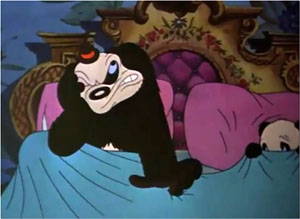 Inside, Andy has to calm his old man’s temper, by reminding him of his high blood pressure (which turns him a shade of bright purple), and suggesting that he count to ten. Papa does so, and the recitation of each number removes one-tenth of his purple hue, until he is calm and seemingly normal again. But the strange house is not conducive to remaining calm for long. “Anybody here?” calls Pop. Half a dozen different voices, both male and female, are heard to repeat the call (including voices that sound like Fred Allen and Eddie “Rochester” Anderson). Then a final voice answers back “Nobody here but us echoes!” Finding no explanation for this phenomenon, the Pandas attempt to settle down in a bed for the night. Andy aggravates Pop with a request for a drink of water – despite the fact that the only cup in the place is fastened to a wall by a chain on the opposite side of the room. When Pop rips the wall apart to loosen the cup, he finds Andy only wanted the water for a place to deposit a pet frog for the night. Pop decides to sleep elsewhere, and bunks down in the seat of a sculpted swan. He soon discovers he has unwisely chosen to make a bed on a merry-go-round, revealed when Andy kicks the starter switch while pursuing his frog across the room. When Pop stops bouncing, he grabs up Andy, depositing him into a back room and shutting him in to spend the night safely distanced from Pop. He fails to notice that the room into which Andy has been placed is the master control room for the mechanics of the entire house. Andy can’t resist all the dials, buttons, and switches he finds inside, and begins turning, pressing, and switching every one of them. Pop finds himself in some strange predicaments, with a water fountain that seems to be haunted, turning off every time Pop wants to take a drink, then force-feeding Pop more water than he can handle, leaving him in a wobbly walk with water sloshing inside him upon every step. A “dance floor” appears, vibrating under Pop to force him to perform many different steps just to keep his balance, while mechanical hands change him into ethnic costumes to match his steps, and even provide him with a dummy partner for a jitterbugging session. Pop is ejected from the floor, crashing through the control room door, and discovers who is behind the house’s strange activity. Seeking to give Andy the spanking of his life, Pop reaches for the nearest piece of wood to use as a paddle – but instead removes a wooden handle of a switch, over which a sign appears, reading “Danger. Do not touch. You’ll be sorry.” The switch sets off a barrage of fireworks, sending the pandas running. They duck into a hole – then emerge within seconds, dodging an emerging artillery shell, fired from the muzzle of the cannon in which they were hidden. A giant jack in the box twirls them around, blowing a roll-out party favor at their rear ends. The pandas race for the front door, Andy again slamming the door behind him into Papa’s face. Pop finally gets out too, and the pandas race down the road, Pop entirely forgetting about the puddle, into which he drops again, sinking to the bottom. Pop turns purple once more while a curious fish swimming in the puddle looks on. Remembering to control his blood pressure, Pop starts counting again, but impatiently speed-counts by twos: “2 – 4 – 6 – 8 – 10.” The result is not pleasing, as he ends up decorated in remaining purple stripes for each number he skipped, looking like an escaped prisoner, as he angrily drums his fingers for the fade out.
Inside, Andy has to calm his old man’s temper, by reminding him of his high blood pressure (which turns him a shade of bright purple), and suggesting that he count to ten. Papa does so, and the recitation of each number removes one-tenth of his purple hue, until he is calm and seemingly normal again. But the strange house is not conducive to remaining calm for long. “Anybody here?” calls Pop. Half a dozen different voices, both male and female, are heard to repeat the call (including voices that sound like Fred Allen and Eddie “Rochester” Anderson). Then a final voice answers back “Nobody here but us echoes!” Finding no explanation for this phenomenon, the Pandas attempt to settle down in a bed for the night. Andy aggravates Pop with a request for a drink of water – despite the fact that the only cup in the place is fastened to a wall by a chain on the opposite side of the room. When Pop rips the wall apart to loosen the cup, he finds Andy only wanted the water for a place to deposit a pet frog for the night. Pop decides to sleep elsewhere, and bunks down in the seat of a sculpted swan. He soon discovers he has unwisely chosen to make a bed on a merry-go-round, revealed when Andy kicks the starter switch while pursuing his frog across the room. When Pop stops bouncing, he grabs up Andy, depositing him into a back room and shutting him in to spend the night safely distanced from Pop. He fails to notice that the room into which Andy has been placed is the master control room for the mechanics of the entire house. Andy can’t resist all the dials, buttons, and switches he finds inside, and begins turning, pressing, and switching every one of them. Pop finds himself in some strange predicaments, with a water fountain that seems to be haunted, turning off every time Pop wants to take a drink, then force-feeding Pop more water than he can handle, leaving him in a wobbly walk with water sloshing inside him upon every step. A “dance floor” appears, vibrating under Pop to force him to perform many different steps just to keep his balance, while mechanical hands change him into ethnic costumes to match his steps, and even provide him with a dummy partner for a jitterbugging session. Pop is ejected from the floor, crashing through the control room door, and discovers who is behind the house’s strange activity. Seeking to give Andy the spanking of his life, Pop reaches for the nearest piece of wood to use as a paddle – but instead removes a wooden handle of a switch, over which a sign appears, reading “Danger. Do not touch. You’ll be sorry.” The switch sets off a barrage of fireworks, sending the pandas running. They duck into a hole – then emerge within seconds, dodging an emerging artillery shell, fired from the muzzle of the cannon in which they were hidden. A giant jack in the box twirls them around, blowing a roll-out party favor at their rear ends. The pandas race for the front door, Andy again slamming the door behind him into Papa’s face. Pop finally gets out too, and the pandas race down the road, Pop entirely forgetting about the puddle, into which he drops again, sinking to the bottom. Pop turns purple once more while a curious fish swimming in the puddle looks on. Remembering to control his blood pressure, Pop starts counting again, but impatiently speed-counts by twos: “2 – 4 – 6 – 8 – 10.” The result is not pleasing, as he ends up decorated in remaining purple stripes for each number he skipped, looking like an escaped prisoner, as he angrily drums his fingers for the fade out.
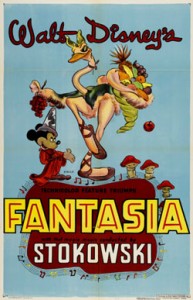 Fantasia (Disney, 11/13/40) – Disney’s “concert feature” includes two uses of weather, neither achieving quite the spectacle of prior dramatic use of the elemets in “Snow White” and “Pinocchio”. In the prehistoric chronicles of “The Rite of Spring”, while there is striking presentation of volcanic eruptions, earthquakes, and tidal waves, little space is devoted to actual inclement weather. Only a few shots of a battle between a T-Rex and a stegosaurus are punctuated by brief rainfall for dramatic effect. In the “Pastoral” sequence, staged in the mythology of the Greek gods, somewhat more “striking” use of lightning is made by Zeus, who appears out of the clouds to enjoy a sporting game of dart-throwing with lightning bolts, disrupting Bacchus’s wine-soaked debauchery going on below. Vulcan forges each lightning bolt for Zeus in the manner of a blacksmith, hammering them into shape on an anvil before tossing them into Zeus’s mighty hands. However, the sequence is highly stylized, much in the manner that would later be used in “Hercules” many years later, and fails to strive for of achieve much in the way of dramatic realism. After making several craters in the earth behind Bacchus and his donkey, and busting up Bacchus’s wine vat (leaving the old reprobate happily wading in and supping from his own brew), Zeus tires of the game, signals Vulcan to cease production, and carelessly disposes of the last few stray bolts underfoot on his cloud, as he rolls over and pulls up the clouds over himself for a comfortable night’s sleep.
Fantasia (Disney, 11/13/40) – Disney’s “concert feature” includes two uses of weather, neither achieving quite the spectacle of prior dramatic use of the elemets in “Snow White” and “Pinocchio”. In the prehistoric chronicles of “The Rite of Spring”, while there is striking presentation of volcanic eruptions, earthquakes, and tidal waves, little space is devoted to actual inclement weather. Only a few shots of a battle between a T-Rex and a stegosaurus are punctuated by brief rainfall for dramatic effect. In the “Pastoral” sequence, staged in the mythology of the Greek gods, somewhat more “striking” use of lightning is made by Zeus, who appears out of the clouds to enjoy a sporting game of dart-throwing with lightning bolts, disrupting Bacchus’s wine-soaked debauchery going on below. Vulcan forges each lightning bolt for Zeus in the manner of a blacksmith, hammering them into shape on an anvil before tossing them into Zeus’s mighty hands. However, the sequence is highly stylized, much in the manner that would later be used in “Hercules” many years later, and fails to strive for of achieve much in the way of dramatic realism. After making several craters in the earth behind Bacchus and his donkey, and busting up Bacchus’s wine vat (leaving the old reprobate happily wading in and supping from his own brew), Zeus tires of the game, signals Vulcan to cease production, and carelessly disposes of the last few stray bolts underfoot on his cloud, as he rolls over and pulls up the clouds over himself for a comfortable night’s sleep.
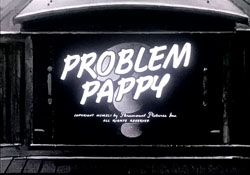 Problem Pappy (Fleischer/Paramount, Popeye, 1/10/41 – Dave Fleischer, dir., Myron Waldman/Sidney Pillett, anim, Tedd Pierce, story) – Poopdeck Pappy is up to his old tricks again – absent from his lifeboat-shaped bed, with a note to Popeye reading “I wuzzent home last night.” Popeye runs out to search for him, commenting that Pappy’s “second childhood is making an old man out of me.” Looking in all the usual places (saloons and dance halls), Popeye finds nothing, but a crowd of onlookers gazing upwards from the base of a tall skyscraper draws Popeye’s attention. Atop a pole at the height of the tower stands Pappy, performing an elaborate juggling act as a flagpole sitter. Popeye shouts for Pappy to come down, but Pappy responds that he took this job to “balance” his budget. While talking, he nearly steps off the pole, barely regaining his precarious perch, and comments, “Looks like it’ll be an early Fall.” Popeye begins the long climb up the tower, scaling row after row of steep stairs, until he appears through a hatchway in the building’s roof. When Pappy won’t come down, Popeye responds, “I’m comin’ up.” Prepared for such an emergency, Pappy produces from his pocket a small can of oil, with which he greases the pole. “Me ol’ ma’s tryin’ to slip one over on me”, mutters Popeye, as he loses all traction, and plunges back to the base of the pole. Since he can’t climb, he thinks of another way to get Pappy down – sock the pole until the vibrations loosen his grip. Pappy takes a few jittery jolts from Popeye’s blows, but takes matters into his own hands, sliding down the pole himself while hanging a sign at the top reading “Back in 2 minutes.” He arrives at the base of the pole headfirst, his hands on the pole and his feet aloft, and uses the position to deliver to Popeye a mule kick right in the jaw. Popeye is seen through the building windows rolling like a pinball down one staircase after another after another, until he emerges in a heap at the ground floor entrance where he started.
Problem Pappy (Fleischer/Paramount, Popeye, 1/10/41 – Dave Fleischer, dir., Myron Waldman/Sidney Pillett, anim, Tedd Pierce, story) – Poopdeck Pappy is up to his old tricks again – absent from his lifeboat-shaped bed, with a note to Popeye reading “I wuzzent home last night.” Popeye runs out to search for him, commenting that Pappy’s “second childhood is making an old man out of me.” Looking in all the usual places (saloons and dance halls), Popeye finds nothing, but a crowd of onlookers gazing upwards from the base of a tall skyscraper draws Popeye’s attention. Atop a pole at the height of the tower stands Pappy, performing an elaborate juggling act as a flagpole sitter. Popeye shouts for Pappy to come down, but Pappy responds that he took this job to “balance” his budget. While talking, he nearly steps off the pole, barely regaining his precarious perch, and comments, “Looks like it’ll be an early Fall.” Popeye begins the long climb up the tower, scaling row after row of steep stairs, until he appears through a hatchway in the building’s roof. When Pappy won’t come down, Popeye responds, “I’m comin’ up.” Prepared for such an emergency, Pappy produces from his pocket a small can of oil, with which he greases the pole. “Me ol’ ma’s tryin’ to slip one over on me”, mutters Popeye, as he loses all traction, and plunges back to the base of the pole. Since he can’t climb, he thinks of another way to get Pappy down – sock the pole until the vibrations loosen his grip. Pappy takes a few jittery jolts from Popeye’s blows, but takes matters into his own hands, sliding down the pole himself while hanging a sign at the top reading “Back in 2 minutes.” He arrives at the base of the pole headfirst, his hands on the pole and his feet aloft, and uses the position to deliver to Popeye a mule kick right in the jaw. Popeye is seen through the building windows rolling like a pinball down one staircase after another after another, until he emerges in a heap at the ground floor entrance where he started.
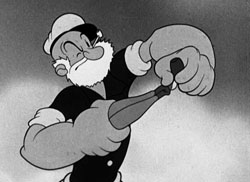 Popeye tries a flanking move, appearing on the roof of the skyscraper across the street. With an extra-long rope, he fashions a lasso, and launches a perfect toss to snag the rope end around Pappy’s flagpole. Popeye then ties off his own end of the rope to a secure spot, and begins a dangerous crossing over the rope as a tightrope walker. Pappy warns Popeye to keep back, and reminds him that it’s a long way down without an elevator – then heartlessly produces a knife, and begins to cut at the rope, remarking “Too bad. He was a good son.” The rope snaps, and Popeye falls, falls, but suddenly stops just short of the ground, caught in a suit of long underwear on someone’s wash line. Popeye gives up, yelling to Pappy that he can stay up there, “and I hope ya falls on your neck.” Pappy laughs victoriously – but doesn’t get much chance to savor the moment, as a violent thunderstorm breaks out. Lightning bolts shoot around Pappy every which way – one even coming so close as to take the time to straighten Pappy’s hat. The old mariner ducks, crouches and cringes to avoid a direct strike, and finally concedes himself, shouting “I quit!” But the lightning is not in a mood to accept his resignation. As Pappy slides down the pole, bolts of lightning repeatedly strike a board at the base of the pole, producing the effect of a carnival high-striker, as every bolt launches Pappy back up to the top of the flagpole, accompanied by the sound effect of the ding of a bell. Popeye can see Pappy needs help, and races up the stairs again. Emerging on the roof, he too dodges the onslaught of the bolts, then produces his spinach can. A well-aimed bolt of lightning hits the can, its tip transforming into the shape of a can opener, to reveal the tasty green leaves. Popeye eats his fill, then charges up the pole. Much like Superman would do in the same year, Popeye socks away at the energy bolts as he advances, knocking them aside right and left. He arrives at the top of the pole, and grabs Pappy under one arm. The lightning is far from through, and uses its jagged form as a saw to sever the pole out from under them. Popeye begins to fall, but performs a feat worthy of Tarzam – grabbing the ends of bolt after bolt, to swing down through the sky like the Lord of the Jungle swings with tree vines. He arrives safely upon the ground, and races Pappy home. That night, he tucks an exhausted Pappy into bed, then retrieves a cup of warm milk for him from the kitchen. When he re-enters the room, Pappy is again no longer in the lifeboat bed – but has not gone far, as he is found sleeping upon the top of the lifeboat’s flagpole, his feet clamped to the tip of the pole as he snores the night away.
Popeye tries a flanking move, appearing on the roof of the skyscraper across the street. With an extra-long rope, he fashions a lasso, and launches a perfect toss to snag the rope end around Pappy’s flagpole. Popeye then ties off his own end of the rope to a secure spot, and begins a dangerous crossing over the rope as a tightrope walker. Pappy warns Popeye to keep back, and reminds him that it’s a long way down without an elevator – then heartlessly produces a knife, and begins to cut at the rope, remarking “Too bad. He was a good son.” The rope snaps, and Popeye falls, falls, but suddenly stops just short of the ground, caught in a suit of long underwear on someone’s wash line. Popeye gives up, yelling to Pappy that he can stay up there, “and I hope ya falls on your neck.” Pappy laughs victoriously – but doesn’t get much chance to savor the moment, as a violent thunderstorm breaks out. Lightning bolts shoot around Pappy every which way – one even coming so close as to take the time to straighten Pappy’s hat. The old mariner ducks, crouches and cringes to avoid a direct strike, and finally concedes himself, shouting “I quit!” But the lightning is not in a mood to accept his resignation. As Pappy slides down the pole, bolts of lightning repeatedly strike a board at the base of the pole, producing the effect of a carnival high-striker, as every bolt launches Pappy back up to the top of the flagpole, accompanied by the sound effect of the ding of a bell. Popeye can see Pappy needs help, and races up the stairs again. Emerging on the roof, he too dodges the onslaught of the bolts, then produces his spinach can. A well-aimed bolt of lightning hits the can, its tip transforming into the shape of a can opener, to reveal the tasty green leaves. Popeye eats his fill, then charges up the pole. Much like Superman would do in the same year, Popeye socks away at the energy bolts as he advances, knocking them aside right and left. He arrives at the top of the pole, and grabs Pappy under one arm. The lightning is far from through, and uses its jagged form as a saw to sever the pole out from under them. Popeye begins to fall, but performs a feat worthy of Tarzam – grabbing the ends of bolt after bolt, to swing down through the sky like the Lord of the Jungle swings with tree vines. He arrives safely upon the ground, and races Pappy home. That night, he tucks an exhausted Pappy into bed, then retrieves a cup of warm milk for him from the kitchen. When he re-enters the room, Pappy is again no longer in the lifeboat bed – but has not gone far, as he is found sleeping upon the top of the lifeboat’s flagpole, his feet clamped to the tip of the pole as he snores the night away.
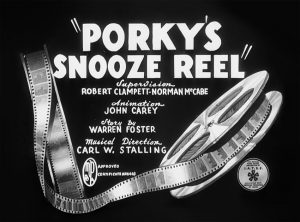 Porky’s Snooze Reel (Warner, Porky Pig, 1/11/41 – Robert Clampett/Norman Mc Cabe, dir.) – Whenever a studio needed a “quickie” to meet quota, spoof a newsreel. Columbia did it. Lantz did it. Fleischer drove it into the ground. And Bob Clampett loved it too. Oddly, he isn’t even willing to put his entire back into this one, passing off half the responsibility to rising name Norman McCabe – hard to believe this weak entry required two brains to create. Actually, in all fairness, it is far from the weakest of such spoofs, slightly funnier than many of its type. For our purposes, only one sequence falls under the category of our trail – a report from Wett, Wash. on an annual flood which has submerged the town. An on-the-spot interview is conducted with the town’s tallest citizen, Long John Sliver, who is seen wading through the town’s main street, nearly shoulder-deep in flood water. He is a gloomy-looking hillbilly type, maintaining a straight, complacent face. The narrator asks if these floods bother him at all “Naw,” replies Long John, then adding, “but my wife is very unhappy!” He raises one arm out of the water, to reveal that he is holding hands with his wife, a short woman who has been completely submerged out of camera view. The gag was not an original, having been lifted directly from the Our Gang short, “Fly My Kite” (1931), in which Farina, shoulder-deep in a huge water puddle, insists that little Stymie is all right, though not visible to the camera, because “I got him by the hand.”
Porky’s Snooze Reel (Warner, Porky Pig, 1/11/41 – Robert Clampett/Norman Mc Cabe, dir.) – Whenever a studio needed a “quickie” to meet quota, spoof a newsreel. Columbia did it. Lantz did it. Fleischer drove it into the ground. And Bob Clampett loved it too. Oddly, he isn’t even willing to put his entire back into this one, passing off half the responsibility to rising name Norman McCabe – hard to believe this weak entry required two brains to create. Actually, in all fairness, it is far from the weakest of such spoofs, slightly funnier than many of its type. For our purposes, only one sequence falls under the category of our trail – a report from Wett, Wash. on an annual flood which has submerged the town. An on-the-spot interview is conducted with the town’s tallest citizen, Long John Sliver, who is seen wading through the town’s main street, nearly shoulder-deep in flood water. He is a gloomy-looking hillbilly type, maintaining a straight, complacent face. The narrator asks if these floods bother him at all “Naw,” replies Long John, then adding, “but my wife is very unhappy!” He raises one arm out of the water, to reveal that he is holding hands with his wife, a short woman who has been completely submerged out of camera view. The gag was not an original, having been lifted directly from the Our Gang short, “Fly My Kite” (1931), in which Farina, shoulder-deep in a huge water puddle, insists that little Stymie is all right, though not visible to the camera, because “I got him by the hand.”
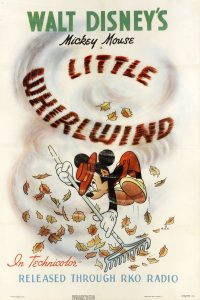 The Little Whirlwind (Disney, Mickey Mouse, 2/14/41 – Riley Thomson, dir.) – A rare near-solo starring effort for Mickey, heavy on personality animation and sight gags rather than on dialogue, and among the mouse’s best performances. Mickey was in a state of flux, a movement seeming prevalent since 1939’s “The Pointer” (the first released cartoon to depict Mickey with small white eyeballs and flesh tone surrounding skin) to continually “modernize” the character to develop him from rubber-hose to state of the art form. Slight variations in design had appeared from cartoon to cartoon (such as significantly smaller eyes in “Pluto’s Dream House”). Director Riley Thompson, however, had his own ideas for a substantial overhaul of Mickey’s persona. His first innovation was to change Mickey’s trademark ears (which, as verbally pointed out by Mickey in an episode of “Mickey Mouse Works”, always jutted out in the same dimensions so as to both be visible no matter what angle the mouse’s head was facing) to ears that, to some degree, moved in natural perspective when he turned his head. The ears could thus be seen in edge-on angles to frame a golfing hat when he appeared in 1941’s Canine Caddy. (Earlier animators might have wished at times they could have taken such liberties in certain shots, as in a sequence of Boat Builders, where the only way the physics of the older design could be observed in an awkward shot of Mickey turning his head while craning his neck upwards was for one ear to briefly pass directly under his chin!) Thompson’s version would also prove that the ears were functional rather than mere black orbs, by including a hollow area on the outer side, colored in dark gray. Thompson would also drastically alter Mickey’s physique, changing his torso from pear-shaped to a trim set of nearly parallel lines. Finally, although present only in a handful of shots, Riley would remember Mickey’s rodent origins, by providing him with longer forward buck teeth, visible when he whistles. (This feature seems to appear only in this one cartoon.) Principal in assisting in this redesign was Fred Moore, who would become Disney’s “Mouse Expert” in later years. His memories of the design work are evident when, in the mid-1940’s, he jumped ship for a few years to assist Dick Lundy’s unit in Dick’s new directorial post at Walter Lantz, where Moore contributed to a similar, more realistic redesign for Andy Panda. Particularly in the model sheet for Lundy’s “The Playful Pelican”, several key poses demonstrating acting and emotion of the character are virtually identical to poses struck by the Mouse from the production of “Whirlwind”, which Moore found retained their usefulness for improving the appearance and performance of two similar “straight-men” characters!
The Little Whirlwind (Disney, Mickey Mouse, 2/14/41 – Riley Thomson, dir.) – A rare near-solo starring effort for Mickey, heavy on personality animation and sight gags rather than on dialogue, and among the mouse’s best performances. Mickey was in a state of flux, a movement seeming prevalent since 1939’s “The Pointer” (the first released cartoon to depict Mickey with small white eyeballs and flesh tone surrounding skin) to continually “modernize” the character to develop him from rubber-hose to state of the art form. Slight variations in design had appeared from cartoon to cartoon (such as significantly smaller eyes in “Pluto’s Dream House”). Director Riley Thompson, however, had his own ideas for a substantial overhaul of Mickey’s persona. His first innovation was to change Mickey’s trademark ears (which, as verbally pointed out by Mickey in an episode of “Mickey Mouse Works”, always jutted out in the same dimensions so as to both be visible no matter what angle the mouse’s head was facing) to ears that, to some degree, moved in natural perspective when he turned his head. The ears could thus be seen in edge-on angles to frame a golfing hat when he appeared in 1941’s Canine Caddy. (Earlier animators might have wished at times they could have taken such liberties in certain shots, as in a sequence of Boat Builders, where the only way the physics of the older design could be observed in an awkward shot of Mickey turning his head while craning his neck upwards was for one ear to briefly pass directly under his chin!) Thompson’s version would also prove that the ears were functional rather than mere black orbs, by including a hollow area on the outer side, colored in dark gray. Thompson would also drastically alter Mickey’s physique, changing his torso from pear-shaped to a trim set of nearly parallel lines. Finally, although present only in a handful of shots, Riley would remember Mickey’s rodent origins, by providing him with longer forward buck teeth, visible when he whistles. (This feature seems to appear only in this one cartoon.) Principal in assisting in this redesign was Fred Moore, who would become Disney’s “Mouse Expert” in later years. His memories of the design work are evident when, in the mid-1940’s, he jumped ship for a few years to assist Dick Lundy’s unit in Dick’s new directorial post at Walter Lantz, where Moore contributed to a similar, more realistic redesign for Andy Panda. Particularly in the model sheet for Lundy’s “The Playful Pelican”, several key poses demonstrating acting and emotion of the character are virtually identical to poses struck by the Mouse from the production of “Whirlwind”, which Moore found retained their usefulness for improving the appearance and performance of two similar “straight-men” characters!
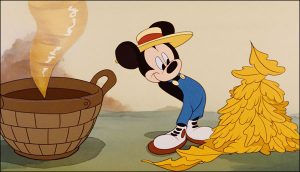 Though this film is truly Mickey’s show, it opens with a brief assist by Minnie Mouse, providing a plot motivation for the action which is to follow. An interesting opening shot begins without either a fade or iris in, but commences in total blackness, lit by the opening of an oven door, as we find our point of view to be from inside the oven, immediately behind a freshly-baked three-layer cake all ready to remove. Minnie sets the cake on the windowsill to cool, and the trail of its aroma attracts Mickey, a passing vagabond and today wearing a straw hat, from his travels along the road. The aroma literally picks Mickey up by both the nostrils and the seat of his pants, floating him over to the window, just as Minnie brings the cake inside onto a shelf, and shuts the window glass in Mickey’s face. Mickey presses his nose to the glass, and attracts Minnie’s attention, indicating in pantomime he’d love a taste of the cake. Opening the window briefly, Minnie coldly remarks, “I’ve nothing for loafers. Good day.” But Mickey hollers that he’ll clean up her yard for a slice, and promises that she won’t know the place when he gets through. (This proves to be a promise that is easily kept, after the disasters which are about to follow.) Mickey quick-changes into a pair of work blue-jeans, and begins raking dead leaves from an autumn onset with a will, piling them into a neat pile. Enter the title “character” of out story – a pint-sized cyclone, endowed with a personality for mischief and a hankering to cause trouble for the fun of it. (Of historical note: Mickey had faced this nearly-identical setup once before, in the opening sequence of 1934’s Playful Pluto, revealing “Whirlwind” to in fact be a clever reworking of the previous cartoon, developing a whole script out of the singular incident in the predecessor production.) As Mickey bends to lift his pile of leaves, with intent to deposit them into a large basket, the whirlwind hides inside the basket, then sucks it upwards to reposition the basket on Mickey’s opposite side. Mickey releases the leaves, which all fall upon open earth instead of in the basket. Scratching his head in confusion. Mickey tries the same task in reverse direction – only to find the basket again moved out of place, back to where it started. This goes on back and forth a number of times, until frustrated Mickey produces from his jeans pocket a hammer and nail, nailing the center of the basket to the ground. Somehow, he fails to see the whirlwind inside, and finally dumps the leaves in the basket, only to have them shot out again into his face by the mischievous breeze. The whirlwind sucks the straw hat off Mickey’s brow, then wears it at a rakish angle to perform a sauntering dance, resembling the signature moves of Maurice Chevalier. As Mickey tries to regain his chapeau, the whirlwind screws the hat tightly onto Mickey’s head, then sucks up Mickey’s pile of leaves, depositing them inside Mickey’s pants. Mickey kicks his legs back and forth to empty the dead leaves from his pant legs, and the whirlwind provides musical accompaniment to the tune of “The Campbells are Coming”, by blowing through a garden hose with a metal sprinkler attachment, appearing out the holes of the sprinkler as eight littler whirlwinds. Mickey and the whirlwind play tug of war with the basket, entirely unraveling it.
Though this film is truly Mickey’s show, it opens with a brief assist by Minnie Mouse, providing a plot motivation for the action which is to follow. An interesting opening shot begins without either a fade or iris in, but commences in total blackness, lit by the opening of an oven door, as we find our point of view to be from inside the oven, immediately behind a freshly-baked three-layer cake all ready to remove. Minnie sets the cake on the windowsill to cool, and the trail of its aroma attracts Mickey, a passing vagabond and today wearing a straw hat, from his travels along the road. The aroma literally picks Mickey up by both the nostrils and the seat of his pants, floating him over to the window, just as Minnie brings the cake inside onto a shelf, and shuts the window glass in Mickey’s face. Mickey presses his nose to the glass, and attracts Minnie’s attention, indicating in pantomime he’d love a taste of the cake. Opening the window briefly, Minnie coldly remarks, “I’ve nothing for loafers. Good day.” But Mickey hollers that he’ll clean up her yard for a slice, and promises that she won’t know the place when he gets through. (This proves to be a promise that is easily kept, after the disasters which are about to follow.) Mickey quick-changes into a pair of work blue-jeans, and begins raking dead leaves from an autumn onset with a will, piling them into a neat pile. Enter the title “character” of out story – a pint-sized cyclone, endowed with a personality for mischief and a hankering to cause trouble for the fun of it. (Of historical note: Mickey had faced this nearly-identical setup once before, in the opening sequence of 1934’s Playful Pluto, revealing “Whirlwind” to in fact be a clever reworking of the previous cartoon, developing a whole script out of the singular incident in the predecessor production.) As Mickey bends to lift his pile of leaves, with intent to deposit them into a large basket, the whirlwind hides inside the basket, then sucks it upwards to reposition the basket on Mickey’s opposite side. Mickey releases the leaves, which all fall upon open earth instead of in the basket. Scratching his head in confusion. Mickey tries the same task in reverse direction – only to find the basket again moved out of place, back to where it started. This goes on back and forth a number of times, until frustrated Mickey produces from his jeans pocket a hammer and nail, nailing the center of the basket to the ground. Somehow, he fails to see the whirlwind inside, and finally dumps the leaves in the basket, only to have them shot out again into his face by the mischievous breeze. The whirlwind sucks the straw hat off Mickey’s brow, then wears it at a rakish angle to perform a sauntering dance, resembling the signature moves of Maurice Chevalier. As Mickey tries to regain his chapeau, the whirlwind screws the hat tightly onto Mickey’s head, then sucks up Mickey’s pile of leaves, depositing them inside Mickey’s pants. Mickey kicks his legs back and forth to empty the dead leaves from his pant legs, and the whirlwind provides musical accompaniment to the tune of “The Campbells are Coming”, by blowing through a garden hose with a metal sprinkler attachment, appearing out the holes of the sprinkler as eight littler whirlwinds. Mickey and the whirlwind play tug of war with the basket, entirely unraveling it.
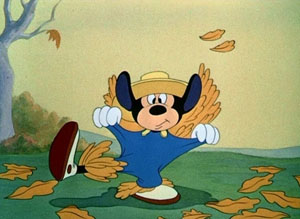 Then, the whirlwind, making melodic whistling sounds as if a pied piper, sucks along behind him a precision parade of leaves, seeming to march in single file behind him like a squad of well-trained soldiers. (This scene feels so much like something Lundy might have used in his Walter Lantz days, not dissimilar to the dancing “Apple Core-Us” girls of “Apple Andy”.) Mickey, in poses again reminiscent of later Andy Panda films, trapses behind the parade in nonchalant fashion, carrying a large sack. He waits until the parade rounds the corner of a tool shed, then pulls back in hiding around the corner, reversing direction in stealthy steps to lie in wait at the opposite corner for the parade to complete its rounds of the building. As the whirlwind emerges around the side, Mickey throws the sack over it. But holding a wind inside the sack is the rough equivalent of riding a bucking broncho, as Mickey gallops all around the yard. He tries to bout with the sack like a punching bag, but the trapped wind battles back with a sock to Mickey’s gut. Finally, the rope holding the wind inside the sack unties, and the whirlwind is set free. Mickey races after it, slashing back and forth at it with the end of a long rake. Mickey and the wind disappear down a country road, the wind seeming in a wispy whistle to be calling out, “Mama! Mama!”. It turns out the whirlwind is not just speaking figuratively – as Mickey suddenly appears back over the hills, running in reverse, and finding himself pursued by a giant midwestern twister who is in fact the whirlwind’s “mother”. (Several shots in this sequence are drawings recycled from “The Band Concert”.) The little whirlwind remains in the rear of the action, cheering on mother, as Mickey tries to stay one jump ahead of the vengeful cyclone. The violent wind uproots structures, twists trees into spirals, and digs deep furrows in the landscape. A long strip of soil upon which Mickey is standing is uprooted, providing a treadmill course for Mickey to run upon, racing at full speed but seeming to get no further from the cone of the cyclone, as the strip of land is consumed within the cyclone’s whirling aperture. A funny shot has Mickey collide with a lawn mower upon the disappearing strip, then forced to push it along to keep pace against the consuming wind, thus mowing the grass as he runs. As the strip of land nears its end, Mickey leaps through a doorway ripped from the side of someone’s house, then into the bucket and down the shaft of an uprooted water well. The bucket reaches its rope limit at the base of the well, and Mickey finds his direction reversed, as the upper portions of the well are about to be consumed by the cyclone. He gasps as he enters the whirling cone, and is dragged through the length of the rotating brown chaos, then abruptly deposited out the other end, headfirst into a fountain and fish pond in Minnie’s back yard. The landscape now substantially trashed, the cyclone and its offspring whirlwind depart over the horizon, satisfied with their results. Inside her house, Minnie has somehow remained oblivious to all that has transpired outside, ad emerges with her fully-frosted and decorated cake to present a reward to Mickey. She shrieks in shock at the sight that meets her eyes – twisted structures, random items piled like totem poles, and Mickey balanced upon a stream of water from her half-wrecked fountain. “Surprise”, utters Mickey sheepishly. Minnie turns a water valve, shutting off the water under Mickey and depositing him in the fish pond. Emptying out a fish from his straw hat, Mickey states what he believes is a foregone conclusion – “Well, guess I don’t get the cake, huh?” To his surprise, Minnie responds, “Oh, yes, you do!” – and to Mickey’s greater surprise, he receives the cake, thrown as a bulls-eye shot upon his head. Tipping the top layer of the cake as if his hat in a gesture to say “Thank you”, Mickey finds consolation in nibbling at the cherry and top frosting above his head, as the scene irises out.
Then, the whirlwind, making melodic whistling sounds as if a pied piper, sucks along behind him a precision parade of leaves, seeming to march in single file behind him like a squad of well-trained soldiers. (This scene feels so much like something Lundy might have used in his Walter Lantz days, not dissimilar to the dancing “Apple Core-Us” girls of “Apple Andy”.) Mickey, in poses again reminiscent of later Andy Panda films, trapses behind the parade in nonchalant fashion, carrying a large sack. He waits until the parade rounds the corner of a tool shed, then pulls back in hiding around the corner, reversing direction in stealthy steps to lie in wait at the opposite corner for the parade to complete its rounds of the building. As the whirlwind emerges around the side, Mickey throws the sack over it. But holding a wind inside the sack is the rough equivalent of riding a bucking broncho, as Mickey gallops all around the yard. He tries to bout with the sack like a punching bag, but the trapped wind battles back with a sock to Mickey’s gut. Finally, the rope holding the wind inside the sack unties, and the whirlwind is set free. Mickey races after it, slashing back and forth at it with the end of a long rake. Mickey and the wind disappear down a country road, the wind seeming in a wispy whistle to be calling out, “Mama! Mama!”. It turns out the whirlwind is not just speaking figuratively – as Mickey suddenly appears back over the hills, running in reverse, and finding himself pursued by a giant midwestern twister who is in fact the whirlwind’s “mother”. (Several shots in this sequence are drawings recycled from “The Band Concert”.) The little whirlwind remains in the rear of the action, cheering on mother, as Mickey tries to stay one jump ahead of the vengeful cyclone. The violent wind uproots structures, twists trees into spirals, and digs deep furrows in the landscape. A long strip of soil upon which Mickey is standing is uprooted, providing a treadmill course for Mickey to run upon, racing at full speed but seeming to get no further from the cone of the cyclone, as the strip of land is consumed within the cyclone’s whirling aperture. A funny shot has Mickey collide with a lawn mower upon the disappearing strip, then forced to push it along to keep pace against the consuming wind, thus mowing the grass as he runs. As the strip of land nears its end, Mickey leaps through a doorway ripped from the side of someone’s house, then into the bucket and down the shaft of an uprooted water well. The bucket reaches its rope limit at the base of the well, and Mickey finds his direction reversed, as the upper portions of the well are about to be consumed by the cyclone. He gasps as he enters the whirling cone, and is dragged through the length of the rotating brown chaos, then abruptly deposited out the other end, headfirst into a fountain and fish pond in Minnie’s back yard. The landscape now substantially trashed, the cyclone and its offspring whirlwind depart over the horizon, satisfied with their results. Inside her house, Minnie has somehow remained oblivious to all that has transpired outside, ad emerges with her fully-frosted and decorated cake to present a reward to Mickey. She shrieks in shock at the sight that meets her eyes – twisted structures, random items piled like totem poles, and Mickey balanced upon a stream of water from her half-wrecked fountain. “Surprise”, utters Mickey sheepishly. Minnie turns a water valve, shutting off the water under Mickey and depositing him in the fish pond. Emptying out a fish from his straw hat, Mickey states what he believes is a foregone conclusion – “Well, guess I don’t get the cake, huh?” To his surprise, Minnie responds, “Oh, yes, you do!” – and to Mickey’s greater surprise, he receives the cake, thrown as a bulls-eye shot upon his head. Tipping the top layer of the cake as if his hat in a gesture to say “Thank you”, Mickey finds consolation in nibbling at the cherry and top frosting above his head, as the scene irises out.
Here, enjoy the “Have-A-Laugh” version:
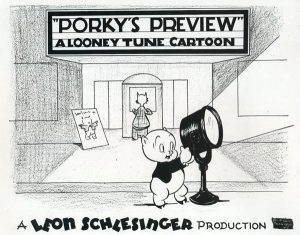 Porky’s Preview (Warner, Porky Pig, 4/19/41 – Fred (Tex) Avery, dir.) – Almost a “cheater” film, finding even less for Porky to do than in the newsreel discussed above, the pig only appearing in brief wraparound shots at the beginning and end of the film. (These short scenes would be Avery’s only dealings with the streamlined rediesign of Porky which would become his standard look for the 1940’s and beyond.) The remaining content of the film is certainly a savings on budget as well – as it is entirely presented in child-like stick figure scrawl, as the handiwork of the pig himself in his own production of his first amateur cartoon. (“Shucks, it wasn’t hard, ‘cause I’m an artist.”) Still, many scenes continue to produce laughs and smiles, showing the influence of the Avery hand. One shot pushes the censorship envelope a bit, as a hula girl who is nothing but a line stick-figure has her grass skirt fall off and drop to her feet, revealing of course, nothing but lines. She, however, is morally mortified, shouts out, “Oh, oh, OH!”, and dashes for cover out of frame. The weather angle of the film comes from a finale production number, featuring a face caricature atop stick figure of blackface Al Jolson, reprising to a sour musical backing his feature number from the earlier cartoon, “September In the Rain”, as oversized raindrops plop down in unrealistic fashion around and upon him. As the final curtain falls, all that is left to applaud Porky’s efforts is a skunk, who the theater had been trying to exclude from admission all through the picture.
Porky’s Preview (Warner, Porky Pig, 4/19/41 – Fred (Tex) Avery, dir.) – Almost a “cheater” film, finding even less for Porky to do than in the newsreel discussed above, the pig only appearing in brief wraparound shots at the beginning and end of the film. (These short scenes would be Avery’s only dealings with the streamlined rediesign of Porky which would become his standard look for the 1940’s and beyond.) The remaining content of the film is certainly a savings on budget as well – as it is entirely presented in child-like stick figure scrawl, as the handiwork of the pig himself in his own production of his first amateur cartoon. (“Shucks, it wasn’t hard, ‘cause I’m an artist.”) Still, many scenes continue to produce laughs and smiles, showing the influence of the Avery hand. One shot pushes the censorship envelope a bit, as a hula girl who is nothing but a line stick-figure has her grass skirt fall off and drop to her feet, revealing of course, nothing but lines. She, however, is morally mortified, shouts out, “Oh, oh, OH!”, and dashes for cover out of frame. The weather angle of the film comes from a finale production number, featuring a face caricature atop stick figure of blackface Al Jolson, reprising to a sour musical backing his feature number from the earlier cartoon, “September In the Rain”, as oversized raindrops plop down in unrealistic fashion around and upon him. As the final curtain falls, all that is left to applaud Porky’s efforts is a skunk, who the theater had been trying to exclude from admission all through the picture.
Popeye Meets Rip Van Winkle (Fleischer/Paramount, Popeye, 5/9/41 – Dave Fleischer, dir., Myron Waldman/Sidney Pillett, anim.), receives honorable mention. Despite it being a part of the original Van Winkle legend that thunder in the Catskill mountains was the result of games of ninepins played by the ghosts of Henry Hudson’s crew, no other cartoon to this point in time seems to have incorporated this part of the story – even though games of bowling were included in prior versions, there was never any correlation with thunder. In this version, Popeye passes a house where a dispossession is in progress. Chico Marx makes a cameo appearance as a piano mover, while Rip Van Winkle is left sleeping on the doorstep, as the Sheriff pastes on the door an eviction order for non-payment of rent for 20 years. Conscientious Popeye decides to perform a good deed, by bringing the snoring old-timer to his own home to sleep it off. After tucking him into bed, Popeye leaves Rip unattended momentarily to prepare a warm drink for him to soothe his snoring. But Rip is a sleepwalker, and rises from his bed, headed for the front door. One cute gag has him walk into the edge of the open door, then attempt to correct his “near-sightedness” by putting on a pair of rectangular spectacles, even though his eyes are still closed in sound sleep. He exits the house, and Popeye returns, not only discovering the empty bed, but hearing and seeing thunder ad lightning out the window. Popeye runs out in search of the old man.
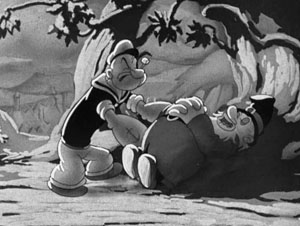 High in the mountains, Popeye roams, following the source of the thunder. He discovers Rip, still sound asleep, but comfortably resting under a tree, at the edge of a ninepin alley where the elves representing the Henry Hudson crew play at their game. Popeye tries to shush their loud strikes, pointing out that Rip is sleeping. “Get off the alley”, is the response of the elves, and one climbs up Popeye’s shirt to deliver a series of blows to Popeye’s jaw. Popeye resists fighting back, due to the small size of his opponent. “If you was bigger…” The elf attempts to satisfy this request, by calling his slightly-taller big brother, who repeats the same socking of Popeye’s jaw. “Popeye don’t fight with no infinks. If I was your size, I’d show ya’.” The second elf calls to the others, “If he was our size…” In a scene that was somewhat unsettling to me as a youth, and still surprising, the elves gang up on Popeye, violently pounding down upon him – and the mighty sailor finds his torso and lower limbs compressed like an accordion bellows. Try as he might, he is unable to extend them back to normal length, and in one contortion stands upon his forearms, with his feet elevated and unable to reach the ground. With their foe reduced to manageable size, the first elf socks Popeye, who rolls backwards, scoring a strike upon the pins in the alley. Popeye retaliates with a sock to the elf’s jaw, rolling him backwards into the rest of the elves, knocking them skyward, only to land back upon the alley in bowling pin formation. Popeye follows up with a real bowling ball to score a strike upon the elves. But the elves turn to their available ammunition, and begin launching a barrage of bowling balls and pins at Popeye. Popeye retreats, but remembers he hasn’t yet rescued Rip. Finally turning to his spinach can, Popeye manages to reverse the effects of the elves’ compression beating, but disappointingly does not wreak any vengeance on the elves for their unsocial behavior. Instead, he merely grabs up Rip, and carries him back to the safety of the house. This time, Popeye undresses Rip before tucking him into bed, and hangs his clothes upon a chair. A small dime falls out of Rip’s pants pocket, and clinks upon the floor. This is enough to finally awaken Rip. “Oh, a pickpocket, huh?” shouts the old man, grabbing up his musket. Popeye is unable to explain, kept busy dodging musket balls, one of which enters a picture of a large ship on Popeye’s wall, and sinks the mighty vessel into the painted bay, for the iris out.
High in the mountains, Popeye roams, following the source of the thunder. He discovers Rip, still sound asleep, but comfortably resting under a tree, at the edge of a ninepin alley where the elves representing the Henry Hudson crew play at their game. Popeye tries to shush their loud strikes, pointing out that Rip is sleeping. “Get off the alley”, is the response of the elves, and one climbs up Popeye’s shirt to deliver a series of blows to Popeye’s jaw. Popeye resists fighting back, due to the small size of his opponent. “If you was bigger…” The elf attempts to satisfy this request, by calling his slightly-taller big brother, who repeats the same socking of Popeye’s jaw. “Popeye don’t fight with no infinks. If I was your size, I’d show ya’.” The second elf calls to the others, “If he was our size…” In a scene that was somewhat unsettling to me as a youth, and still surprising, the elves gang up on Popeye, violently pounding down upon him – and the mighty sailor finds his torso and lower limbs compressed like an accordion bellows. Try as he might, he is unable to extend them back to normal length, and in one contortion stands upon his forearms, with his feet elevated and unable to reach the ground. With their foe reduced to manageable size, the first elf socks Popeye, who rolls backwards, scoring a strike upon the pins in the alley. Popeye retaliates with a sock to the elf’s jaw, rolling him backwards into the rest of the elves, knocking them skyward, only to land back upon the alley in bowling pin formation. Popeye follows up with a real bowling ball to score a strike upon the elves. But the elves turn to their available ammunition, and begin launching a barrage of bowling balls and pins at Popeye. Popeye retreats, but remembers he hasn’t yet rescued Rip. Finally turning to his spinach can, Popeye manages to reverse the effects of the elves’ compression beating, but disappointingly does not wreak any vengeance on the elves for their unsocial behavior. Instead, he merely grabs up Rip, and carries him back to the safety of the house. This time, Popeye undresses Rip before tucking him into bed, and hangs his clothes upon a chair. A small dime falls out of Rip’s pants pocket, and clinks upon the floor. This is enough to finally awaken Rip. “Oh, a pickpocket, huh?” shouts the old man, grabbing up his musket. Popeye is unable to explain, kept busy dodging musket balls, one of which enters a picture of a large ship on Popeye’s wall, and sinks the mighty vessel into the painted bay, for the iris out.
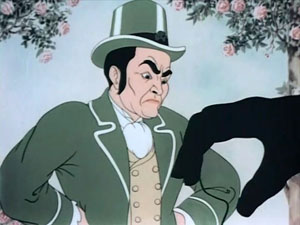 Aviation Vacation (Warner, Merrie Melodies, 8/2/41 – Fred (Tex) Avery, dir.) – Another of Avery’s travelogue spoofs, a bit less inspired than usual. It is very akin to the previous Land of the Midnight Fun, this time concentrating gags (several of which misfire) upon airline travel rather than a steamship. It may perhaps be most remembered for a somewhat-failed effort to put over a gag that would later be perfected at MGM as one of Avery’s biggest laughs – a hair caught in the projector, interfering with the image seen on the screen, until a character in the film does something about it, by pausing the action to insist that the projectionist take it out. (The revisit to the gag in MGM’s Magical Maestro would do it one better, having Butch the bulldog pause to himself pluck the irritating hair from the edge of the film frame.) For our weather purposes, the film includes two gags of note – a view of sunny California, “where the sun is always shining” – depicted by a sky with one small patch of clear sunlight in the center, surrounded on all sides by thick black clouds sending a torrential downpour upon the countryside. The finale of the film is a near duplicate of “Midnight Fun”, as the plane encounters a pea-soup fog, and is told to circle the field. When the fog lifts, the plane is tethered to the wires of a carnival airplane ride, left to continue circling with the other tethered planes, again and again and again.
Aviation Vacation (Warner, Merrie Melodies, 8/2/41 – Fred (Tex) Avery, dir.) – Another of Avery’s travelogue spoofs, a bit less inspired than usual. It is very akin to the previous Land of the Midnight Fun, this time concentrating gags (several of which misfire) upon airline travel rather than a steamship. It may perhaps be most remembered for a somewhat-failed effort to put over a gag that would later be perfected at MGM as one of Avery’s biggest laughs – a hair caught in the projector, interfering with the image seen on the screen, until a character in the film does something about it, by pausing the action to insist that the projectionist take it out. (The revisit to the gag in MGM’s Magical Maestro would do it one better, having Butch the bulldog pause to himself pluck the irritating hair from the edge of the film frame.) For our weather purposes, the film includes two gags of note – a view of sunny California, “where the sun is always shining” – depicted by a sky with one small patch of clear sunlight in the center, surrounded on all sides by thick black clouds sending a torrential downpour upon the countryside. The finale of the film is a near duplicate of “Midnight Fun”, as the plane encounters a pea-soup fog, and is told to circle the field. When the fog lifts, the plane is tethered to the wires of a carnival airplane ride, left to continue circling with the other tethered planes, again and again and again.
More skies less than blue, in ‘41 and ‘42, next time.



 Charles Gardner is an animation enthusiast who toils by day as a member of LA Law – but by nights and weekends indulges in classic jazz and ragtime as a performer; and studies classic Hollywood cartoons… maybe a little too much.
Charles Gardner is an animation enthusiast who toils by day as a member of LA Law – but by nights and weekends indulges in classic jazz and ragtime as a performer; and studies classic Hollywood cartoons… maybe a little too much.


































































































































































There is a third depiction of weather in Fantasia, as the “Waltz of the Flowers” segment shows the changing of seasons from autumn to winter. First, the naked fairies paint the leaves in autumn colours; then they paint everything with frost; and finally, snow begins to fall. Apart from a few that have completely gone to seed, there are no flowers in “Waltz of the Flowers”.
In “The Little Whirlwind”, Mickey gets hit in the face with a copy of the Bridgeport Post. That’s a real newspaper, or at least it used to be, suggesting that the cartoon takes place in the state of Connecticut.
Pop Panda’s silent “C’mon” isn’t the only crazy thing about the “Crazy House” soundtrack. When Andy is activating the controls for the dance floor, a voiceover translates “dance floor” into another language.
At least the hair in the projector in “Aviation Vacation” helps distract the viewer’s attention from the Irish tenor’s rotoscoped hideousness. That guy really gives me the creeps.
I’ve always loved the scene with the “Bridgeport Post”. It was animated by Walt Kelly, later of “Pogo” fame, and amounts to a quick in-joke tribute to his home town. The innovations in Mickey’s design were not the work of Riley Thomson (properly spelled without the “p”). They were undertaken by Fred Moore and, in particular, Ward Kimball, who was gaining a level of freedom at the studio and didn’t hesitate to use it. Moore and Kimball were taking liberties with Mickey, who they felt had become increasingly constricted by his nice-guy image on the screen. According to entries in Kimball’s diary, Walt enjoyed the changes and encouraged them — then later changed his mind.
When I was still-framing the twister segment I spotted the “Bridgepost Post” banner on the newspaper and, being a Walt Kelly fan, bells went off and I decided to submit this to the trivia section of the IMDb’s entry for “The Little Whirlwind”:
“While running from the hurricane, Mickey is smacked in the face by a copy of the The Bridgeport (Connecticut) Post. Walt Kelly, later the creator of Pogo, was an animator at Disney at this time and in the 1930s had been a cartoonist and reporter for this, his hometown newspaper.”
“Somewhat failed effort”? I thought that gag was the part in the otherwise disappointing “Aviation Vacation”.
Another travelogue: “The Land of Fun” (Columbia/Screen Gems, Color Rhapsodies, 18/4/41 — Sid Marcus, dir.) takes us to a variety of vacation destinations in what is obviously meant to be California, though the state is never mentioned by name. The humour, such as it is, stems from the disparity between the narration and what happens on screen. For example: “Let’s visit the beach and enjoy the feel of the warm sand between our toes!” We see a spectacled nebbish on a beach so crowded that he has to walk along on top of the other beachgoers. “Let’s say hello to Doctor Sunshine!” The sky fills with clouds, lightning strikes, rain begins to pour, and the throngs of vacationers instantly vacate the beach. Moments later, the sun returns, and suddenly the beach is just as packed as it was before.
The cartoon studios got a lot of mileage out of those paeans to sunny California followed by heavy rainfall, and we haven’t seen the last of them yet.
“Rover’s Rescue” (Terrytoons, 28/6/40 — Volney White, dir.) opens with a dog sitting in front of the fireplace on a cold day and reading a book titled “How to Win Friends and Influence Cats”. (What kind of dog would write a self-help book for dogs who want to make friends with cats? Airedale Carnegie?) Suddenly there is a flash of lightning, and a cold wind from outside blows open the shutters. As Rover closes them, he sees through the window a small kitten walking through the blizzard. The kitten slips off a snow-covered riverbank and falls through the ice into the cold water. Wasting no time, Rover hurries to the rescue, pulls the kitten out of the river, brings it into the house and revives it with a hot water bottle. The kitten, however, shows a complete lack of gratitude and spurns all of Rover’s attempts to make friends, for example spitting in his paw when he tries to shake hands. After reading the title of Rover’s book, the kitten leaves, ostensibly preferring the cold winter storm to the dog’s company, and Rover is left alone in tears. But then the kitten summons all the alley cats in the neighbourhood and leads them back to the house, along with a gift-wrapped bone for the dog. Now Rover has more cats for friends than he knows what to do with.
This series has made me aware that I’m woefully uninformed on effects animators. Can anyone recommend resources on the history and development of effects animators?
Mickey is pretty rubbery in “Little Whirlwind.”